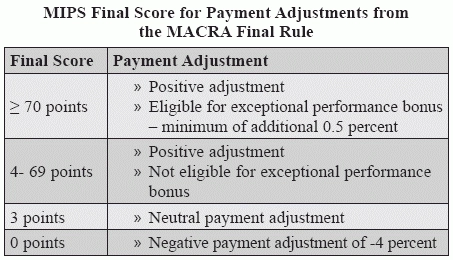MACRA Pick Your Pace Options
How Will Emergency Groups Meet The Quality and PI Category Requirements? If you've been wondering what emergency physicians will need to do to satisfy the requirements under MACRA, CMS offers some guidance in the MACRA final rule about what emergency physicians will need to do to satisfy the requirements for the relevant components for hospital based providers. For the MIPS Quality Category Score Detail, clinicians would choose six measures to report versus nine measures previously required under PQRS. The prior domains are de-emphasized in 2017, but you must report on 50 percent of Medicare patients. You may choose a specialty specific measure set and a cross cutting measure is not required now for claims based reporting, says Michael A. Granovsky, MD, FACEP, CPC, President of LogixHealth, a national emergency medicine coding and billing company based in Bedford, MA. For the Clinical Practice Improvement Activities, the focus is on care coordination, beneficiary engagement, and patient safety, which clinicians would select from a list of more than 90 options among nine categories and attest to performing. These include: Of those listed, emergency preparedness may be a good fit for emergency medicine groups and includes participation in the Medical Reserve Corps, measuring registration in the Emergency System for Advance Registration of Volunteer Health Professionals (ESAR-VHP), measuring relevant reserve and active duty military MIPS eligible clinician or group activities, and measuring MIPS eligible clinician or group volunteer participation in domestic or international humanitarian medical relief work. The goal is to ensure that practices remain open during disaster and emergency situations and support emergency response teams as needed, like after 9/11 or when there is a need for help in areas hit by terrorist attacks, Granovsky explains CMS "Pick Your Pace" Plan allows Four Options for MIPS For the transitional year 2017, CMS established four paths providers may follow, each with the minimum performance threshold. The four paths are: Penalty: Not participating in the Quality Payment Program by not sending in any 2017 data, will earn you a -4 percent payment adjustment. Neutral: If you submit a minimum amount of 2017 data to Medicare (for example, one quality measure or one improvement activity), you can avoid a downward payment adjustment. Partial Bonus: If you submit 90 days of 2017 data to Medicare, you may earn a neutral or small positive payment adjustment. Full Bonus: If you submit a full year of 2017 data to Medicare, you may earn a small or moderate positive payment adjustment. MIPS Scoring and the Composite Performance Score MIPS annually measures clinicians to derive a total composite performance score (CPS) of 0-100 based on performance in each of the four performance categories. Each clinician's CPS is compared to a benchmark called a Performance Threshold, which will be the statistical mean or median (at CMS' discretion on an annual basis) of the CPSs for all MIPS clinicians during a period prior to the performance period. Payment adjustments will be made when comparing an Eligible Clinician's CPS to the Performance Threshold (PT). Providers will be graded using four quartiles above and below the performance threshold. Your position in the quartile will determine whether you get the maximum penalty or the maximum bonus in the target year. MACRA allows a potential three times upward adjustment for the highest performers, but achieving that is unlikely. Those in the exceptional bonus pool could qualify for additional bonus money from a separate $500 million dollar pool, though this too will be tough for 2017, Granovsky says.


